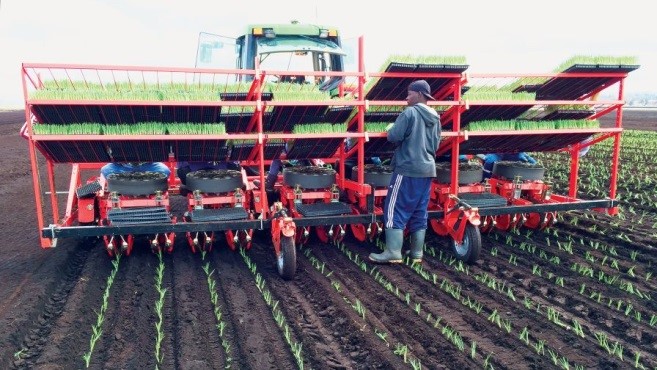Selecting a Mechanical Transplanter
Rice Seedling Mechanical Transplanter – Source: Rice Crop Guide – Growing Rice – Haifa Group
One of the key challenges to small landholders is achieving timeliness of operations. With the high costs associated with finding and retaining good workers when growing small acreages of crops; whether for a market or a community-supported system, the decision to mechanize certain operations can be a tough one.
A good example is in the decision to purchase a mechanical transplanter. While hand planting can be effective and efficient with the right hand-tools and people accomplishing the task, there are associated inefficiencies as well… achieving the right depth of planting across the entire field; achieving straight rows for in-field operations later; keeping workers focused and fresh; having consistent distance between plants.. all these and more can lead the manager to decide it’s time to go mechanical.

Transplanter technology has come a long way in modern Agriculture. Here, there is room for six workers on one planter, each setting two rows at a time.
Photo courtesy of Photo courtesy of Grant Allen and Checchi & Magli (C&M)
Source: Six things to consider when picking out a planter or transplanter – Growing Vegetables
Factors to review before buying a mechanical transplanter
The cost of a GOOD mechanical transplanter can be substantial when money is tight. Purchasing agricultural equipment comes down to how many days in a year might you be keeping that capital ‘busy’, allowing you to achieve a ROI (Return on Investment) over the life of the equipment. Since planters and transplanters fall into that narrow window at planting crops; they often will be overlooked in favor of other equipment that has multiple uses throughout the season.
The quality of transplanters varies considerably. There are many considerations a farmer must go through, including:
- Is it set up to plant a number of crops? Some transplanters are not as universal as others. Depth control, finger configuration, openers, press wheels, and other considerations all come together to help with this decision. Usually, small landholders may need to stagger plantings of several crops across the season. Having a transplanter that can be adjusted and calibrated for several crops is a huge advantage.
- Watering – when sticking transplants, water for the first week or two is crucial; and it’s especially important right after transplanting. Transplants will inevitably wilt, lose their turgor and strength, and lodge. Having a watering attachment and an efficient delivery system is a huge plus..but comes at additional cost. Placement of the water at the plant furrow (not on the plant) is very important.
- Soil-Root Contact – of all the considerations when transplanting, this is the most crucial. Roots must be firmly in contact with the soil..air is a killer with transplanting. This is accomplished with three steps.. the furrow opener; the finger placement; and the firming wheels that follow. All the while making sure the plants are not buried, or planted too shallow to where the upper roots of the plant dry out.
- Starter fertilizer – usually, this is accomplished with another pass. Some transplanters allow for a fertilizer attachment which can band fertilizer near (not with) the root of the plant. Some systems will use a liquid fertilizer at a very low concentration to help the plants as they try to root, but the rate of application must be controlled well in this configuration to prevent damage to the young roots. Quite often, unless in very cold soils, starter fertilizer isn’t necessary if good nutrient management exists.
Row Selection – typically, on small farms, a two-row configuration is most common. One person rides on the transplanter, and the operator drives at the appropriate speed so they can keep up with the transplant mechanism, usually setting a single row; although certain modern planters allow for two rows per person.

Heavy Duty 812F Trailer 2-1000 Units : drawbar configuration with heavy duty construction with a multitude of add-ons available Source: Mechanical Transplanter – Pull Type
So if you’re considering the acquisition of a transplanter, read more about it. See what crops you can use a given planter for; look at the condition and type of finger and placement mechanisms it has; analyze the weight and depth control flexibility; along with the other factors above…. Then consider price. The only thing worse than not having a transplanter is having one that doesn’t fit your needs.
Video:
By: John Deibel



